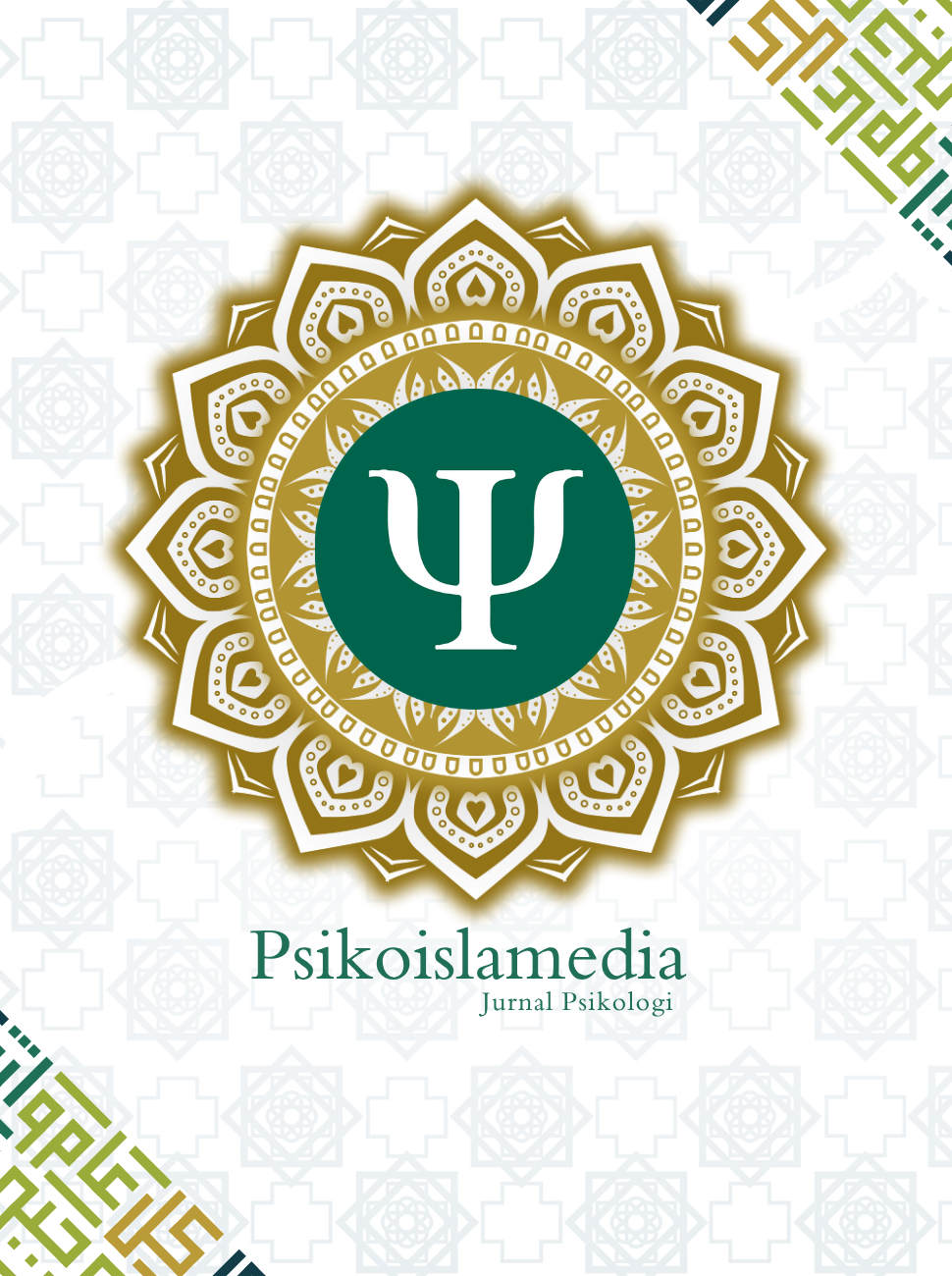INFLUENCE OF PATHOLOGICAL NARCISISM, INDECENT DRESSING AND LEARNED HELPLESSNESS ON SEXUAL HARASSMENT EXPERIENCE AMONG UNDERGRADUATE STUDENTS IN FEDERAL UNIVERSITY, OYE-EKITI, NIGERIA
DOI:
https://doi.org/10.22373/psikoislamedia.v9i1.21859Keywords:
Narcissism, indecent Dressing, Learned helplessness, Sexual harassment experienceAbstract
This study was conducted to examine the influence of pathological narcissism, indecent dressing, and learned helplessness on the experience of sexual harassment among students of the Federal University Oye-Ekiti, Nigeria. The study adopted the correlational research design and was guided by three research questions. It involved 284 undergraduate students between the ages of 16 and 21 who were selected through stratified random sampling using the stratum of faculty. Pathological Narcissism Inventory (α=.94), The Learned Helplessness Scale (α=.91) Indecent Dressing Measure (α=.90) and Sexual Harassment Scale (α=.88) were used as measuring instruments. The data were analysed using the Pearson Product Moment Correlation and multiple regression. The results showed that narcissistic (r(284)= .372; p<1), narcissistic vulnerability (r(284)= .339; p<1), indecent dressing(r(284)= .408 p<1), and learned helplessness (r(284)= .314 p<1) positively correlated with sexual harassment. The three main predictor variables together accounted for 31% of the total variance in sexual harassment (F(4,283) = 32.858; R= .566; R2= .320; Adj. R2=.310; P<.01). In addition, the three independent variables individualistically contributed to predicting sexual harassment: learned helplessness (β=.079; t=3.036, P<.01); indecent dressing (β=.160; t=6.767, P<.01); narcissistic grandiosity (β= .184; t= 4.329, P<.01); and narcissistic vulnerability (β=.063; t=2.068, P<.05). The three independent variables explored in this study are sufficiently forceful to influence sexual harassment among undergraduates. Therefore, the study concluded that sexual harassment among undergraduates can be reduced when behaviour change agents take into account the variables considered in this study while diagnosing and preferring solutions to vulnerability to sexual harassment on campuses.
References
Abimbola, O. O. & Ugbede, O.T (2018). Gender differences in risky behaviour, learned helplessness and school connectedness among undergraduates in Osun State. Gender & Behaviour, 16(1), 11073 - 11084
Aina-Pelemo, A. D., Oke, O. A., & Alade, I.T. (2021). Quid pro quo sexual harassment: Comparative study of its occurrences in selected institutions in South-West, Nigeria. Current Research in Behavioral Sciences, 2, https://doi.org/10.1016/j.crbeha.2021.100031
Akanbi, S. T. (2021). Grandiose against vulnerable narcissism among undergraduate students in Oyo State, Nigeria: differential effect of some demographic factors. Journal of Humanities Therapy, 12(1), 111-135.
Akpan, G. E. (2018). Effects of indecent dressing on undergraduate students of university of Uyo, Uyo, Nigeria. International Journal of Physical Education, Sports and Health, 5.(2), 359-365.
American Psychiatric Association (2000). Diagnostic and Statistical Manual of Mental Disorders (4th ed, Text Revision). Washington, DC.
Anadi C.C, Egboka P.N, and Aniorobi E.I. (2011). Indecent dressing among female undergraduates of Nnamdi Azikiwe University: Types, Sustaining factors and implications for rebranding Nigeria agenda. Nigeria Journal of Sociology of Education. 5(1),1-12.
Anwar F, Osterman K, & Björkqvist K. (2022). Sexual Harassment and Psychological Well-being. Eurasian Journal of Medical Investigation, 6(2), 227–239.
Australian Human Rights Commission (2018). Everyone’s business: Fourth national survey on sexual harassment in Australian workplaces. Retrieved on July, 28, 2023, from http://www.humanrights.gov.au/about/publications/
Barbier, J. M., Carrard, V., Schwarz, J., Berney, S. , Clair, C., & Berney, A. (2023) Exposure of medical students to sexism and sexual harassment and their association with mental health: a cross-sectional study at a Swiss medical school. British medical journal Open 13:e069001. doi: 10.1136/bmjopen-2022-069001
Beninger, C. (2013). Combating sexual violence in schools in sub-Saharan Africa: Legal strategies under regional and international human rights law. African Human Rights Law Journal, 13(2), 281-301.
Birhan, W. (2019). A review on normative and other factors contributing to Africa’s adolescent development crisis. Philosophical Papers and Reviews, 91,1-9.
Blinkhorn, V., Lyons, M., & Almond, L. (2015). The ultimate femme fatale? Narcissism predicts serious and aggressive sexually coercive behavior in females. Personality and Individual Differences, 87, 219–223. https://doi.org/10.1016/j.paid.2015.08.001.
Burn, S. M. (2019). The Psychology of sexual harassment. Teaching of psychology 46(1), 96-103.
Burnett, D. (2018). How 'provocative clothes' affect the brain – and why it's no excuse for assault. The Guardian. Retrieved from https://lubbil.ngontinh24.com/article/how- provocative-clothes- affect-the-brain-and-why-it-s-no-excuse-for-assault on October 7, 2022.
Christensen, J. (2018) .Learned Helplessness, the Structure of the Telemachy and Odysseus’ Return. In J. Lauwers, H. Schwall & J. Opsomer,(Eds.) Psychology and the Classics: A Dialogue of Disciplines. Berlin, Boston: De Gruyter, pp. 129-141. https://doi.org/10.1515/9783110482201- 009.
Chukwudi, F. & Gbakorun, A. A. (2011). Indecent Dressing and Sexual Harassment among Undergraduates of Nasarawa State University, Keffi. Journal of Sociology, Psychology and Anthropology in Practice, 3(2), 28-31.
Cotney, L.A.C. (1997). Child sexual abuse and learned helplessness as predictors of revictimization of young adult women. PhD Dissertation, University of Georgia
Dickhäuser, O., Reinhard, M. A., and Englert, C. (2011). Of course, I will: the combined effect of certainty and level of expectancies on persistence and performance. Social Psychology of Education, 14, 519–528. doi: 10.1007/s11218-011-9159-x
Duba, A., Messiaen, M., Boulangeat, C., Boucekine, M., Bourbon, A., Viprey, M., Auquier, P., Lançon, C., Boyer, L., & Fond, G. (2020). Sexual harassment exposure and impaired mental health inmedical students. The MESSIAEN national study. Journal of Affective Disorders. 274, 276–281. https://doi.org/10.1016/j.jad.2020.05.100.
Egwim, C. (2010). Indecent Dressing among Youths. Retrieved July, 27, 2023 from http://www.es/networld.com/webpages/features
Erinosho, S. Y., Femi-Oyewo, M. N. & Oduwole, E. O. (2018). Sexual harassment on campus: a study in a Nigeria university. Agogo: Journal of Humanities, 4, 1-10.
Filippello, P., Buzzai, C., Costa, S., Orecchio, S., & Sorrenti, L. (2020). Teaching style and academic achievement: The mediating role of learned helplessness and mastery orientation. Psychology in the Schools, 57(1), 5–16. https://doi.org/10.1002/pits.22315
Finn J. 2021. Psychological abuse and learned helplessness – A systematic literature review. Retrieved on July 28, 2023 from https://scholarsphere.psu.edu. doi:10.26207/04cn-0d46
Fitzgerald, L. F. (1996). Sexual harassment: The definition and measurement of a construct. In M. A. Paludi (Ed.), Sexual harassment on college campuses: Abusing the Ivory Power (pp. 25–47). State University of New York Press.
Ganu, J. & Boateng, A., B. P. (2013). Examining sexual harassment experiences in the Ghanaian work environment: Behavioural responses and effects on both women and men. Nigeria Journal of Management Sciences, 3(1), 1-12
Gyawali, K. (2020). Sexual harassment and its effects on the mental health of the adolescents school girls in Lalitpur and Rupandehi District. Tribhuvan University Journal, 35, 2. 72- 88. DOI: https://doi.org/10.3126/tuj.v35i2.36192.
Hall, C., Goodwin, D., Heleski, C., Randle, H., and Waran, N. (2008). Is there evidence of learned helplessness in horses? Journal of Applied Animal Welfare Science 11(3),249– 266. doi: 10.1080/10888700802101130
Hejase, H. J. (2021). The Economics of Sexual Harassment. Journal of Economics and Economic Education Research. 22(2), 1-3.
Hockenbury, D.H. & Hockenbury, S.E. (2010). Discovering Psychology (Fifth Edition). New York. Worth Publishers.
Holtzman, N. S., & Donnellan, M. B. (2015). The roots of narcissus: Old and new models of the evolution of narcissism. In V. Zeigler-Hill, L. L. M. Welling, & T. K. Shackelford (Eds.), Evolutionary perspectives on social psychology (pp. 479–489). New York: Springer International Publishing.
Ibrahim A. & Haruna A. (2014). The Psycho-Social Aspect of Indecent Dressing: Influence of Gender, Dress Pattern and Physical Attractiveness on Sexual Harassment Journal of Humanities and Social Science, 19(3), 25-31.
Imonikhe, J., Idogho, P. & Aluede, O (2011). A Survey of Teachers’ and Students’ Perception of Sexual Harassment in Tertiary Institutions of Edo State, Nigeria. African Research Review, 5, 412-423.
Jones, D. N., & Olderbak, S. G. (2014). The associations among dark personalities and sexual tactics across different scenarios. Journal of Interpersonal Violence, 29, 1050–1070.
Kheswa, J. G. (2014). Exploring the Causal Factors and the Effects of Sexual Harassment on Female Students at the Universities in Africa: An overview. Mediterranean Journal of Social Sciences, 20, 2847- 2852.
Koepernik, T. Jauk, E & Kanske, P. (2021). Lay theories of grandiose and vulnerable narcissism. Current Psychology, 41, 8862–8875. https://doi.org/10.1007/s12144-020-01296-w
Lamarche, V. M., & Seery, M. D. (2019). Come on, give it to me baby: Self-esteem, narcissism, and endorsing sexual coercion following social rejection. Personality and Individual Differences, 149, 315–325. https://doi.org/10.1016/j.paid.2019.05.060
Maciver, J. E. (2017). Sexual Harassment of Niger Delta University, Bayelsa State’s Students: Factors and Consequences. Journal of Resourcefulness and Distinction, 14(1), 1-12.
Malesza, M., & Kaczmarek, M. C. (2018). Grandiose narcissism versus vulnerable narcissism and impulsivity. Personality and Individual Differences, 126, 61–65. https://doi.org/10.1016/j.paid.2018.01.021
Malkin , C. (2016). Rethinking Narcissism. Harvard Medical School
Mapayi, B., Oginni, O., Ukpong, M., & Harrison, A. (2023). Correlates of Sexual Harassment Among Staff and Students in First Generation South West Nigerian Universities. BJPsych Open, 9(S1), S59-S60. doi:10.1192/bjo.2023.210
Molstad T. D., Weinhardt J. M., & Jones R. (2023). Sexual assault as a contributor to academic outcomes in university: a systematic review. Trauma, Violence and Abuse 24, 15248380211030247. 10.1177/15248380211030247
Mouilso, E. R., & Calhoun, K. S. (2016). Personality and perpetration: Narcissism and psychopathy among college sexual assault perpetrators. Violence against Women, 22, 1228–1242. doi: 10.1177/1077801215622575
Mowle, E. N. (2019). Psychopathy, Narcissism, and the Big Five: Understanding Sexual Assault Perpetration and Bystander Intervention. Unpublished PhD Dissertation Texas A&M University
Muoghalu, C. O & Olaoye, R. I. (2016). Perception of sexual harassment among students of Obafemi Awolowo University, Ile Ife, Nigeria. The Nigerian Journal of Sociology and Anthropology, 14(2) DOI: 10.36108/NJSA/6102/14(0290).
Norah, A. E. (2020). Sexual harassment and assault on female students in some tertiary institutions in Ekiti State: Impact on emotional stability. International Journal of Management, Social Sciences, Peace and Conflict Studies, 3(2), 84-95.
Nuvvula S. (2016). Learned helplessness. Contemporary Clinical Dentistry, 7(4), 426-427.
Nwikpo, M. N., Anierobi, E.I., Eluemuno, A. I. Ezennaka, A. O. & Ezeonwumelu, V. U. (2022). Indecent dressing among female undergraduates on sexual conduct and study engagement of their male counterparts in universities in the Southeast Nigeria. European Journal of Education and Pedagogy,3(6), 36-44
Obande-Ogbuinya, N. K, Aleke, C. O. Omaka-Amari, L. N, Mong, E.U, Afoke, E. N, Ben Ngozi Ohuruogu, B. N., et al. (2022). Prevalence of sexual harassment and its relationship with family birth order among female undergraduates: New findings from institutional-based cross-sectional study in the south east, Nigeria. African Journal of Reproductive Health, 26 (11), 56-66. DOI: 10.29063/ajrh2022/v26i11.6.
Obeta, A.& Uwah, B. (2015). Determinants of dressing patterns of female undergraduates’ students in tertiary institutions in Abia State, Nigeria. Rural Environment Education Personality, 15, 245- 251.
Odabasi, B. (2013). The effect of learned helplessness to the success. International Journal of Academic Research. 5, 125-133. doi: 10.7813/2075-4124.2013/5-4/B.18.
Ogunbameru, K. (2006). Sexual Harassment in Nigerian Tertiary Institutions. Ibadan. Spectrum Books Limited.
Okondu O. E., John N., Afolabi, R. A., Atulomah, N. S., Ikonta P. C., Okafor U. G., et al., (2020). Prevalence of sexual harassment in a faith-based institution of higher learning in South-Western Nigeria. Global Journal of Health Science, 12(13), 1-8. doi:10.5539/gjhs.v12n13p1.
Oluwadare, O. O., Otunaiya, A. O., & Opeoluwa, S. R. (2020). Indecent dressing and its implications on academic performance of female undergraduates: Tai Solarin University of education experience. International Journal of Management, Social Sciences, Peace and Conflict Studies, 3(2), 31–41.
Omede, J. (2011). Indecent Dressing on Campuses of Higher Institutions of Learning in Nigeria: Implications for Counselling. Journal of Emerging Trends in Educational Research and Policy Studies, 2, 228-233.
Omorogiuwa, T. B. E. (2018). Sexual harassment among university students in Nigeria: Prevalence, psychosocial factors and prevention. Bangladesh Education Journal, 17(2), 25-33.
Onoyase, A. (2019). Prevalence of sexual harassment of female students of tertiary education in Taraba State, North East Nigeria: Implications for counselling. International Journal of Higher Education 8(1), 77-83 http://ijhe.sciedupress.com.
Osagiobare, E. O.; Ekwukoma, V. & Ekomaru, C. I. (2015). Forms of indecent dressing among university students in north central geo-political zone. Sokoto Educational Review 16 (1), 94- 101.
Pasta, T., Mendola, M., Longobardi, C., Prino, L. E., and Gastaldi, F. G. M. (2013).Attributional style of children with and without a specific learning disability. Electronic Journal of Research in Educational Psychology, 11, 649-655. doi: 10.14204/ejrep.31.13064
Pincus, A. L., & Lukowitsky, M. R. (2010). Pathological narcissism and narcissistic personality disorder. Annual Review of Clinical Psychology, 6, 421-446.
Pincus, A. L., Ansell, E. B., Pimentel, C. A., Cain, N. M., Wright, A. G. C., & Levy, K. N. (2009). Initial construction and validation of the Pathological Narcissism Inventory. Psychological Assessment, 21(3), 365–379. https://doi.org/10.1037/a0016530
Pittiglio, L. (2017). Learned Helplessness and Sexual Risk Taking in Adolescent and Young Adult African American Females. AIDS Patient Care and STDs, 31(8), 356-361
Quinless, F. W., & Nelson, M. M. (1988). Development of a measure of learned helplessness. Nursing Research, 37, 11-15.
Sabato, T. M. (2009). Predicting HIV/AIDS-related risk behaviour among men who have sex with men: An examination of psychosocial perspectives. Journal of Research, IV(2), 6-9
Suleiman, M. S. (2017). Perception of Sexual Harassment among Female Students of Tertiary Institutions in Northern Nigeria. Ife Social Sciences Review, 25(2), 80-89.
Taiwo M., Omole O. & Omole O. (2014). Sexual Harassment and Psychological Consequence among Students in Higher Education Institution in Osun State, Nigeria. International Journal of Applied Psychology 2014, 4(1), 13-18.
UN Committee on the Elimination of Discrimination against Women (CEDAW, 1992), CEDAW General Recommendation No. 19: Violence against women, available at: https://www.refworld.org/docid/52d920c54.html [accessed 28 July 2023]
Vyas, S. (2018). Sexual Harassment Cause Stress: It’s Effects & Consequences. International Journal of Research and Scientific Innovation 5.1:2321–2705.
Wallace, H. M., Scheiner, B. R. M., & Grotzinger, A. (2016). Grandiose narcissism predicts willingness to behave badly, without proportional tolerance for others' bad behaviour. Current Psychology, 35(2), 234-243. doi: 10.1007/s12144-016-9410-x
Worke, M. D., Koricha, Z. B. & Debelew, G. T. (2023). Consequences of exposure to sexual harassment among women working in hospitality workplaces in Bahir Dar City, Ethiopia: a structural equation model. Archives of Public Health, 81, 7. https://doi.org/10.1186/s13690- 02301024-3
Wu, S., & Tu, C. C. (2019). The impact of learning self-efficacy on social support towards learned helplessness in China. Eurasia Journal of Mathematics, Science and Technology Education 15, 2–10. doi:10.29333/ejmste/115457
Yates, S. (2009). Teacher identification of student learned helplessness in Mathematics. Mathematics Education Research Journal, 21(3), 86-106.
Zeigler-Hill, V. & Andrews, D. (2021). Narcissism and Subjective Arousal in Response to Sexual Aggression: The Mediating Role of Perceived Power. Sexes, 2, 189–201. https://doi.org/10.3390/sexes2020017
Zeigler-Hill, V., Besser, A., Morag, J., & Campbell, W. K. (2016). The Dark Triad and sexual harassment proclivity. Personality and Individual Differences, 89, 47–54. https://doi.org/10.1016/j.paid.2015.09.048.
Zeigler-Hill, V., Enjaian, B., & Essa, L. (2013). The role of narcissistic personality features in sexual aggression. Journal of Social and Clinical Psychology, 32(2), 186–199. https://doi.org/10.1521/jscp.2013.32.2.186
Downloads
Published
Issue
Section
License
Authors who publish in this Journal agree to the following terms:
- Authors retain copyright and grant the journal right of first publication with the work simultaneously licensed under Attribution-ShareAlike 4.0 International (CC BY-SA 4.0) allows others to share the work with an acknowledgment of the work's authorship and initial publication in this journal.
- Authors are able to enter into separate, additional contractual arrangements for the non-exclusive distribution of the journal's published version of the work (e.g., post it to an institutional repository or publish it in a book), with an acknowledgment of its initial publication in this journal.
- Authors are permitted and encouraged to post their work online (e.g., in institutional repositories or on their website) prior to and during the submission process, as it can lead to productive exchanges, as well as earlier and greater citation of published work. (See The Effect of Open Acces)














